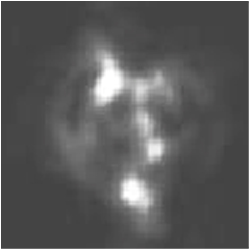|
Using laser beams to measure turbulence
(Right) Figure from Madieh (2008). Simulation of beam scattering in turbulence. Optical measurement of turbulence, achievable with present-day video and computer technology. will be superior to present techniques using specialized and delicate microsensors. Optical techniques could be adapted to ocean-going instrumentation, with possible application to towed bio-sensing systems to deduce upper ocean mixing rates and consequent nutrient fluxes. These data would be relevant to the Boyce et al (2010) observations of phytoplankton decline. I plan to perform experiments in which a laser beam is passed through a laboratory tank of turbulent fluid and projected onto a screen and digitally imaged. Statistical analysis will be based on theories outlined in two Russian books from the '60's (Chernov, 1960; Tatarskii, 1961), to describe the statistical behaviour of light passing through a specified field or spectrum of refractive index variations generated by turbulence. This theory will allow beam behaviour to be specified in terms of the refractive index "Batchelor spectrum" generated by turbulence, and specifically in terms of Epsilon and Chi, the key parameters that are used to characterize turbulent flows and resulting mixing rates (c.f. Oakey, 1982).
|
 A laser beam passing through turbulent fluid is refracted and
scattered, creating a broadened, shimmering beam (like the twinkling
of a star). It should be possible to measure statistical properties
of the beam and infer key turbulence properties such as Chi (the
dissipation rate of thermal fluctuations) and Epsilon (the rate of
dissipation of turbulent kinetic energy). The goal is to develop via
existing theories, and laboratory-test optical measurement techniques
that allow us to measure key turbulence properties.
A laser beam passing through turbulent fluid is refracted and
scattered, creating a broadened, shimmering beam (like the twinkling
of a star). It should be possible to measure statistical properties
of the beam and infer key turbulence properties such as Chi (the
dissipation rate of thermal fluctuations) and Epsilon (the rate of
dissipation of turbulent kinetic energy). The goal is to develop via
existing theories, and laboratory-test optical measurement techniques
that allow us to measure key turbulence properties.